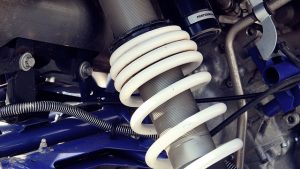
Any spring, regardless of whether it is a torsion, coil, or leaf spring, performs the function of compensating for irregularities that occur in road surfaces, maintaining suspensions systems and predetermined heights, and supporting additional weight without causing excessive sagging.
The geometry of coil windings and the wire’s diameter dictates the spring’s damping performance. Each of these functions is vitally important when it comes to providing comfort, load-bearing capability, and precise handling in modern vehicles. These are the three primary areas that can raise concerns with customers.
Speaking historically, multi-leaf steel springs are among the most widely-used and oldest spring designs when it comes to suspension systems. There are many benefits to leaf springs and not just because they act as springs, but they also directly attach the chassis to the axle.
In certain applications, the “mono-leaf” single spring will be employed. Even though the leaf spring is typically used in trucking applications that feature solid-drive axles, transverse leaf springs are also combined with suspended independent rear axles to arrive at rear suspensions that are lightweight in “performance” road cars.
It is also possible to tune leaf springs to different ride control and load-bearing requirements when changing the thicknesses, lengths, widths, and numbers of the leaf springs.
At the same time, leaf springs tend to act as their own rebound dampeners since the leaves rub together, creating friction. In certain cases, it is possible to replace conventional steel springs with plastic units which dramatically lowers unsprung weight while resisting corrosion caused by road salt along with other elements.
Torsion Springs
The torsion-bar suspension has also been around for several years on vehicles with SLA (short-long-arm) suspension systems. Torsion bars are basically round bars that usually measure four feet in length. They perform the role of twisting as soon as the pressure of weight is applied directly to the suspension system. Since the torsion bars are typically preloaded by either a counterclockwise or clockwise built-in twist, torsion bars only fit the sides of vehicles that they were designed for.
The benefits of torsion-bar suspension systems include their weight and compactness. Since the tension on torsion bars is controlled by threaded screw adjustments, the torsion bar can also be utilized to fine-tune the suspension height. At the same time, a torsion bar can either be attached to the lower and upper control arms, which increased the overall versatility of these designs. If you would like information on the rear suspension system then see here.
Coil Spring
The coil spring function is better understood when you think of this device as a thin and long torsion bar that is wound up into a coil shape. Since these coiled wires twist during the extension and compression cycles of the spring, these coil springs operate on similar principles of torsion bars.
These coil springs occupy a compact space, these devices work in several suspension designs such as the MacPherson strut, independently sprung-rear axles, solid-axles with trailing arms, or any of the SLA suspension systems that use a coil-over-shock absorber or spring configuration.
When replacing springs they must be replaced together (in pairs). If you only replace one at a time, it can cause difficult alignments and poor handling.
Many of the modern imports include variations of coil springs of the MacPherson strut design. In most cases, the wire gauge, the overall diameter, length, and the coil numbers determine the coil springs’ characteristics.
In certain cases, coil springs are designed as variable-weight springs which increase the load-bearing capability when it is compressed. Variable-rate coil springs generally feature in the chassis configurations. These usually only carry occasional heavy loads.
How Do Springs Work?
Springs are designed to cushion the vehicles ride according to sprung-to-unsprung weight ratios. For example, farm wagons without springs will represent 100% unsprung weight. For this example, if the springs were installed in between the axles and the chassis, the sprung-to-unsprung ratio maybe 90% which represents the weight of the chassis, while the remaining 10% represents the wheel and axle weight.